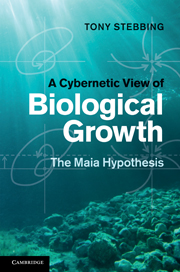Book contents
- Frontmatter
- Contents
- Foreword by Ernest Naylor
- Preface: ‘A fragment of a possible world’
- Acknowledgements
- 1 Introduction
- 2 Growth unlimited: blooms, swarms and plagues
- 3 Self-regulating systems: from machines to humans
- 4 The wealth of homeodynamic responses
- 5 A cybernetic approach to growth analysis
- 6 A control mechanism for Maia
- 7 The three levels of adaptation
- 8 Population growth and its control
- 9 Hierarchy: a controlled harmony
- 10 History of hormesis and links to homeopathy
- 11 Maian mechanisms for hormesis and catch-up growth
- 12 Cellular growth control and cancer
- 13 Human overpopulation
- 14 Our finite Earth
- 15 The Maia hypothesis and anagenesis
- Glossary
- Further reading
- References
- Index
15 - The Maia hypothesis and anagenesis
Published online by Cambridge University Press: 10 January 2011
- Frontmatter
- Contents
- Foreword by Ernest Naylor
- Preface: ‘A fragment of a possible world’
- Acknowledgements
- 1 Introduction
- 2 Growth unlimited: blooms, swarms and plagues
- 3 Self-regulating systems: from machines to humans
- 4 The wealth of homeodynamic responses
- 5 A cybernetic approach to growth analysis
- 6 A control mechanism for Maia
- 7 The three levels of adaptation
- 8 Population growth and its control
- 9 Hierarchy: a controlled harmony
- 10 History of hormesis and links to homeopathy
- 11 Maian mechanisms for hormesis and catch-up growth
- 12 Cellular growth control and cancer
- 13 Human overpopulation
- 14 Our finite Earth
- 15 The Maia hypothesis and anagenesis
- Glossary
- Further reading
- References
- Index
Summary
Evolutionary progress: increased control over and independence of the environment.
Julian HuxleyTypical of anagenesis: increased independence of the environment and increasing command of environmental factors (progression of autonomy).
Bernhard RenschTeleology is a lady without whom no biologist can live. Yet he is ashamed to show herself in public with her.
Ernst BrükeTHE MAIA HYPOTHESIS
Initially the name Maia was given to a cybernetic approach to understanding the control of growth rate in cultured hydroids (Chapter 5). It was reasoned that this may indicate the underlying control of biosynthesis (Chapter 6). The aim was to find a technique to derive the output of the growth control mechanism from traditional cumulative data; and the idea was first applied to the growth of colonies (Laomedea) and, later, populations (Hydra). A feature of the approach, well known to cyberneticists, is to access the output of control mechanisms using perturbation experiments. The data are characteristically oscillatory, and exhibit cybernetic features such as ‘runaway’ and relaxation stimulation. The evidence was corroborated with data from a simulation model incorporating feedback, which reproduced the essential features of the hydroid output. This method was later applied to growth output in yeast cell suspensions with similar results (Chapter 12), which showed that the method was portable between taxa. There was reason to believe that the control requirements of other biological replicators might be similar, from the cell to more complex organisms. These experiments provided the inner loop of what proved to be a dual loop feedback mechanism.
- Type
- Chapter
- Information
- A Cybernetic View of Biological GrowthThe Maia Hypothesis, pp. 399 - 413Publisher: Cambridge University PressPrint publication year: 2010



